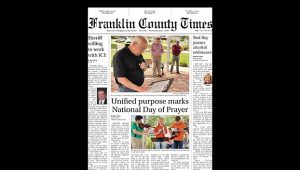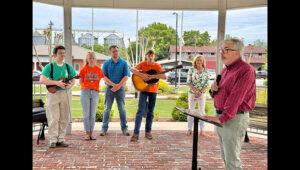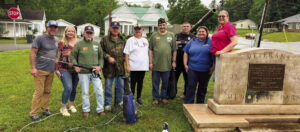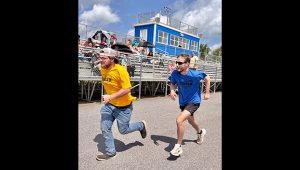Vina man shares passion for trail trees
This marker tree is in Jim Mullins’ back yard, a short hike back into the woods. His mother pointed the tree out to him when he was young.
By Alison James, Managing Editor
alison.james@fct.wpengine.com
“I honestly think it’s very important that people understand because as much timber cutting as goes on around here – People should know what they’re looking at.”
What they might be looking at is a uniquely-shaped tree, designed by Native Americans to serve as a marker tree decades ago, and Jim Mullins wants everyone to understand what these trees look like and what they mean.
Mullins first became interested in these mysterious trees about ten years ago when he picked up a publication that included sketches of trees and rock formations that were believed to have been used by Native Americans as markers for various reasons. One example tree in particular caught his eye.
“It looked familiar to me, but at the time, I couldn’t put my finger on it,” Mullins said. One day it hit him. “I realized that what was familiar to me was a tree right down here that my mother had showed me at one time. So I got really interested in all that.”
The tree was on his grandparents’ property, deep in the woods behind their home – the home Mullins and his wife Denise inherited and now live in, off County Road 23 in Vina. Since first developing an interest in the marker trees, Mullins and his wife have made it a point to seek them out.
This marker tree is off the side of County Road 23, just south of Mullins’ property. Many such trees feature knobby knots like the ones he’s inspecting.
“It’s amazing the number we have stumbled upon on these county roads,” he said.
“I find it quite interesting,” Denise added. “It’s been an adventure.”
So what do these marker trees, or trail trees, look like? Extensive research and mapping has been and is being carried out by a group called the Mountain Stewards. As explained by the Mountain Stewards website, the typical trail tree is a white oak with an abrupt bend several feet from its base. The main trunk then extends horizontally for several feet, terminating with a rounded end that usually has a small mouth. One or more main branches grows vertically from this horizontal segment of the trunk, each becoming a new supporting member for the upper branches of the tree. The horizontal portion of the trunk often slopes downward, either by design or perhaps from the weight of the vertical limbs over time.
“These unique trees are found throughout the United States and are generally interpreted to be trail markers from our American Indian past. But so far, we’ve mostly found speculative and anecdotal reports without much scientific study. We hope that we can provide a central registry for these trees and develop a community of interested parties who can respond to the questions these trees ask with a definite answer,” explains the website.
Mullins himself has sent the Mountain Stewards documentation for a number of trees. “Once I got a feel for what they actually looked like,” he said, he began to notice them easily.
“The meanings of these trees,” the Mountain Stewards website reports, “are not completely known. They may never be known since those who know are all but gone. Some of these trees are found marking old Indian Trails. Others point to water, shelter, stream crossings and more. The techniques for bending a tree into a particular shape have, for the most part, been lost. However, these ‘living artifacts’ are a testimony to the skills and knowledge of the Indian people in their being one with nature.”
Mullins, like the Mountains Stewards, has encountered a range of reactions when he discusses the marker trees with people – from unawareness, to skepticism, to disinterest, to an excitement that parallels his own feelings. But he’s made it a personal mission to seek out these trees and encourage people to be aware of what they mean.
“If they choose to have timber cut – if we did, if I chose to have the timber cut here, I would definitely have (a marker tree) protected. I wouldn’t want them to cut that tree or damage it because it’s part of our history,” Mullins said.
History – both his own, and the history of this nation – is what drives Mullins’ passion for these trees.
“I always came to this farm, and my grandfather was an old-timer,” Mullins said. “He was all about hunting and trapping – he was really old-fashioned … He would take me around the property here and show me different things – there were caves here, and he would trap and do all kinds of different things and show me the natural wonders that were around here. It always sparked my interest.”
To learn more, visit www.mountainstewards.org. A book and a DVD of the same title, “Mystery of the Trees,” are available for purchase to learn more about these “living artifacts.” A map that documents the location of each known marker tree – some 1,700 of them across the nation – is also available to view.










